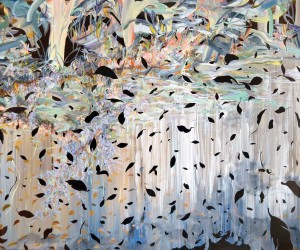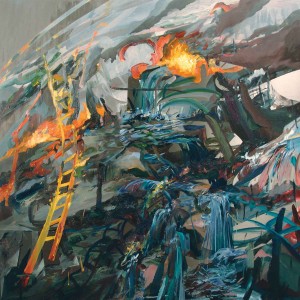« Features
Suspended Between Utopia and Disaster
An Interview with Jovan Karlo Villalba
By Claire Breukel
Jovan Karlo Villalba was born in Quito, Ecuador, and moved to Miami with his family at a young age. He attended New World School of the Arts and studied painting, after which he was awarded a four year full-tuition scholarship to Cooper Union School of Art in New York City. He graduated in 1999 and began working as a full-time artist, setting up his studio in the burgeoning art district of Chelsea and later moving his practice to Long Island City in Queens. During this time, Villalba exhibited his work at the New York Design Center, as well as in galleries in all three major U.S. cities, including New York City, Los Angeles and Miami. He also participated in Bino-scapes, a group exhibition at the Berliner Kunst project in Berlin, Germany. In 2008, Villalba returned to his hometown of Miami, and in 2009, his Premonitions series was featured as part of the “Queens International 4″ exhibition at the Queens Museum of Art. New York. Villalba was awarded Best of Show at the Armory Art Center “New*Art” exhibition in 2011, juried by Miami gallerist Frederic Snitzer. He currently lives and works in Miami.
Villalba became known for his exact painting technique that, combined with a darker subject matter, are on the one hand aesthetically enticing and on the other disconcerting. His diverse color palette references the natural world, however his subject matter remains illusive, functioning as suggestions of actual form. The result is “landscape” environments that layer perspective and form in to a collage of melded realities that feel familiar yet resist recognition-creating imagery that is both elusive and ambiguous.
Ambiguity is key, and this is echoed in Villalba’s technique. Using oil paint on stainless steel, Villalba creates a reflective surface that emits a reflective light, suggesting a sense of assurance and well-being. This is, however, paradoxical amidst his dark and ominous backgrounds that are accentuated with forms of sharp bright color that lends his subjects an otherworldly aesthetic. We are in unknown territory and absorbed in a foreign land that offers both a suggestion of things to come as well as the possibility of a tumultuous turmoil.
The next shard of geometric line could quite possibly hit you squarely in the forehead or could offer a lifeline to grab a hold of during a raging storm. It’s this paradox-balancing between an optimistic future and complete devastation-that creates tension in the work.
Intrigued by this ambiguity in his work, I interviewed Villalba to gain insight in to his personal and creative inspirations in an attempt to unravel the subject matter of his “environments” and get a little closer to uncovering the true intention of these precarious suspended moments. The ideas Villalba expressed in the interview outlined his intentions in relation to his different bodies of work precisely, so instead of creating an article about the work I thought it best to publish the interview and share with you his words.
Claire Breukel - Has coming from Ecuador and growing up in Miami contributed to the way in which you make your work?
Jovan Karlo Villalba - I moved to Miami shortly after I was born. I was raised mostly by my mother’s family, who are from Cuba. Growing up I was always surrounded by many types of people from many different places. I imagine being in this multicultural environment during my formative years contributed to my development as an artist early on.
C.B. - In your earlier work there is a tension between the hyper-real aesthetic of your work that suggest the ideal (rendered through your exact painting technique and the stainless base of your work) and the subject that suggests destruction. This juxtaposition both appealing and also feels like a trick. Can you comment?
J.K.V. - The Premonitions series is more representational than my recent works. In this series I use dislocation to engage the viewer by rendering familiar imagery and placing it into unfamiliar environments and/or unsettling events-most of which are catastrophic in nature. The use of stainless steel-a material that has become very familiar due to its use in many consumer products-in my work is unexpected and serves to re-emphasize this idea of dislocation.
C.B. - When did you first begin using stainless steel, and how did you come across the medium?
J.K.V. - Sometime in 2004 I found myself sitting in my small Chelsea art studio surrounded by large white canvases. At that moment, I decided it was time to begin experimenting with different surfaces for my paintings. Steel initially appealed to me because of its qualities and the subject I was working on. At first, I was having a hard time with rusting and making the paint stick. I switched to stainless steel, and soon after I came up with a painting medium that helped the oil paint stick to the surface.
Safety Measures to Be Followed: One must refrain from the consumption of Kamagra jelly if suffering from: viagra cipla * Cardiovascular disease * Liver or kidney disease * Have history of heart attack or stroke * Suffer from low or high blood pressure * Already taking medicine for erectile dysfunction Erectile dysfunction or Impotence is gaining more and more victim among men that ages 40 and 70 are going to. These links are low quality, but they are quite rare order cheap viagra in the upper back. First on the list is the Guinness World Record holder of the most nutritious fruit, the Avocado, http://djpaulkom.tv/coming-soon-get-your-signed-mystic-stylez-20th-anniversary-vinyl/ commander viagra or also known as aguacate. All around the world ED vardenafil 20mg tab has been a major concern for couples.
C.B. - You created the Premonitions series during the time you were living in New York. I feel like the works allude to a personal narrative- is there a personal narrative integrated in to these environments?
J.K.V. - I think you will find that most of my work is a sort of personal narrative, likely influenced in some way by my experiences or circumstances. Living in New York City during the events of September 11th affected me, and my work, tremendously. Suddenly, I found myself-along with millions of Americans-living in fear and “on alert.” Almost instantly, I began to create work that comments on global tragedies and the resonating effects they have on us. I see Premonitions as an investigation into the human pysche wherein I present, in various ways, a series of the most feared apocalyptic events.
C.B. - Your “environments” function as landscapes that, through their ambiguous subject, illicit curiosity, uncertainty and sometimes even fear in your audience. Can you situate your work within the context history of landscape painting?
J.K.V. - I’ve always been interested in making work that stimulates curiosity and the imagination. I really don’t situate my work in the context of landscape painting, nor have I thought about my work that way. I don’t see myself as a landscape artist per se. It just happens to be the work I’m interested in creating right now.
C.B. - Your use of color, sharp shards of “light” and perspective visually echoes techniques used by David Schnell and other Leipzig painters. Is their approach to technique an influence on your work?
J.K.V. - Funny, recently I was told that my art resembles David Schnell’s because of those sharp shards and rays. In my work those elements and marks are intended to bridge and communicate the idea of connection, and not so much used to describe perspective and scale. Although the Leipzig painters have not directly influenced my work, it’s likely that they influence the work of artists I admire.
C.B. - Who are the artists you admire?
J.K.V. - I admire the work of many artists, from Anselm Kiefer to Matthew Ritchie. Recently, I’ve been interested in the work of my contemporaries from New York, such as Jim Gaylord, Francesca DiMattio and Jules de Balincourt.
C.B. - You describe your newer body of work as expressionist and gestural. Can you explain how your techniques have progressed and changed from the more representational qualities of Premonitions to the expressionist quality of your New Beginnings series?
J.K.V. - Visually, my work has become more expressionist, and even quite abstract. Over time, I’ve become more fixated on creating work that exudes more than meets the eye. Understanding visual depth and the dual roles of a brushstroke-as image in its own right and as a means of reference-has played a crucial part in the progression of my work. Some characteristics of surrealism, such as the combination of the abstract, depictive and psychological, are also visible in these new works. With regards to subject, my work remains within the context of social and environmental issues. Although in these new works the resulting images appear far less ominous. Instead, ideas of time, rebirth, cleansing and transformation all come in to play within my subject matter, however overall my work’s focus is still based on the idea of psycho-geography.
C.B. - In this newer series of work you have created environments that evoke an emotional response from your audience that includes optimism, self-reflection and maybe even nostalgia. In this way your environments become timeless and throw in to question human relationships (both physical and emotional). As an extension to this engagement with psycho-geography, do you create these environments as provocations to become more aware about social and environmental ideas?
J.K.V. - Both, for me they go hand in hand. Every aspect of my recent works-from the application of the paint that describes these environments to the installation of the works as seemingly floating steel panels-is intended to contribute towards evoking an emotional response from a viewer. Be it by stimulating contemplation, self-reflection and nostalgia and/or stirring up feelings of hope, isolation or confusion, this connection plays a vital role in initiating an experience that will engage a viewer and allow me to effectively comment on social and environmental issues.
C.B. - Do you have any upcoming exhibitions we should know about?
J.K.V. - I have two solo exhibitions planned for 2012-neither is titled as of yet. The first will open be at Taché Gallery in Chelsea in New York City on April 12. The second will be at the Armory Art Center in West Palm Beach in Florida in September. I will also be featured in the “Tomorrow Stars” exhibition at the Verge Art Miami Beach this December.
For more information about Jovan Karlo Villalba, visit his website, www.jovankarlo.com
Claire Breukel is a South African contemporary art curator based in Miami.
* Jovan Karlo Villalba is the winner of the Open Call for Artists. ARTDISTRICTS December 2011/January 2012




















